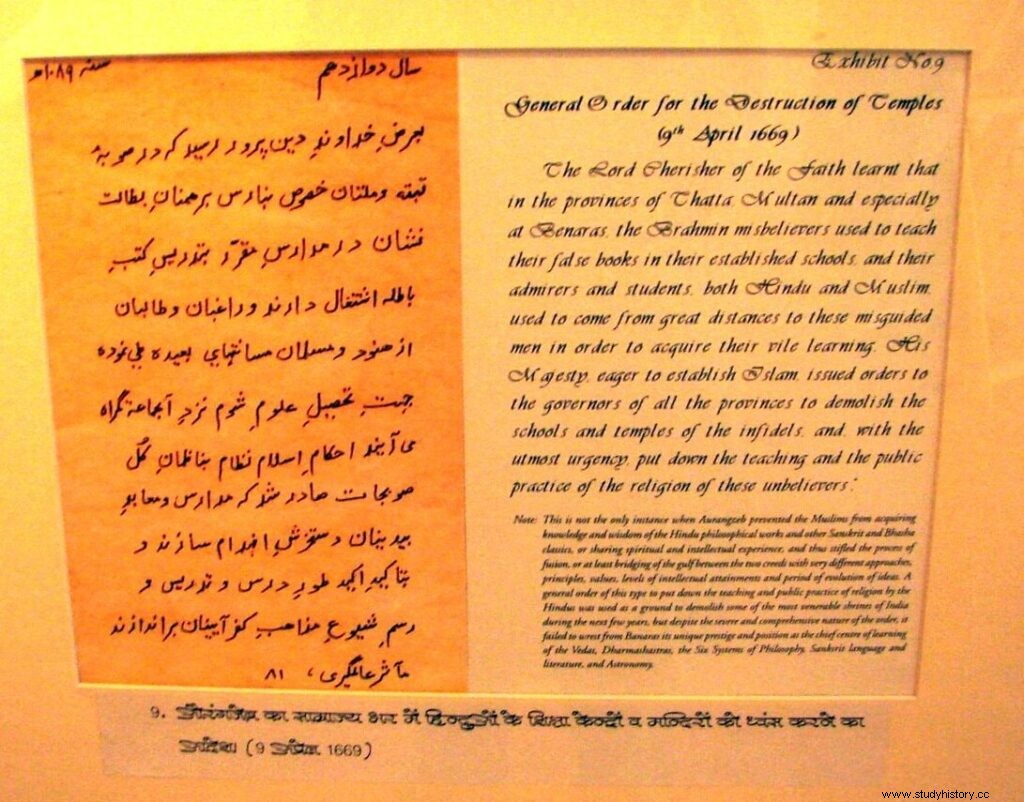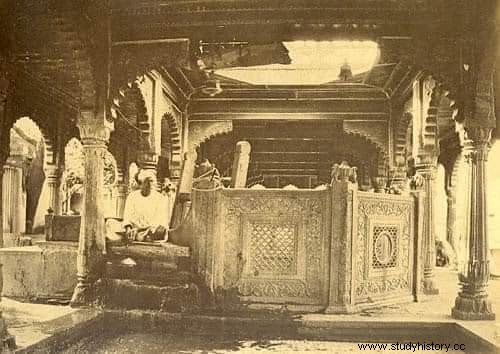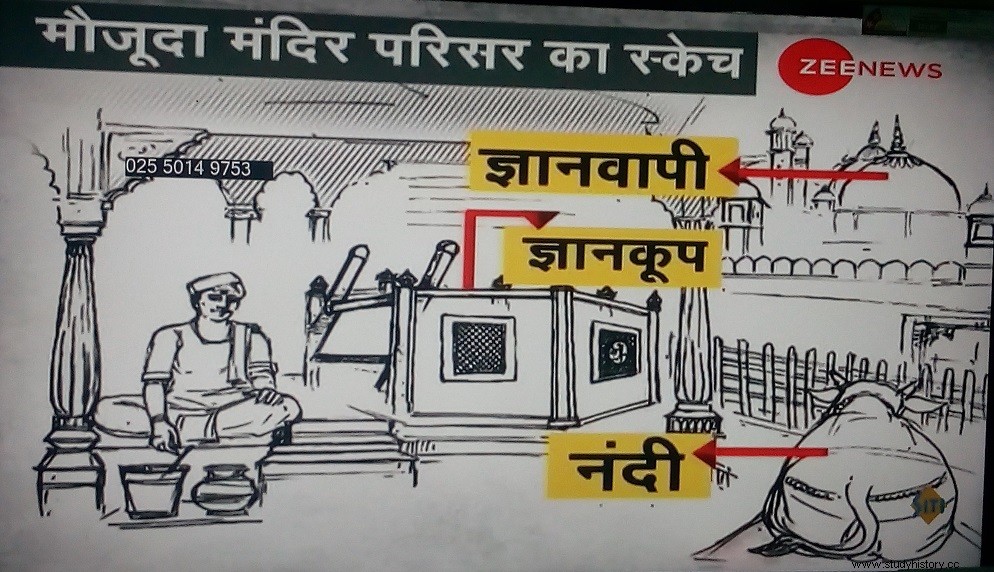The entire Gyanvapi Kashi Vishwanath temple complex including today's disputed "Gyanvapi" was known as Vishweshara Jyotirlinga Temple since time immemorial. This temple was built on astrological basis like other big ancient temples of India and Eurasia like Mecca (Arab), Vatican (Rome), Ravak (Khotan) etc.
There is no information about who was the first to build the Vishweshwar temple in Kashi. All the information related to the temple is related to its restoration and reconstruction. The mention of this temple is found in Mahabharata, Upanishads, Puranas etc. There are many mythological stories related to the temple. The main knowledge-vapi Kashi Vishwanath temple is mentioned in detail in the Kashi section of Skanda Purana. In 1460, Vachaspati has described in his book 'Tirtha Chintamani' that Avimukteshwar and Visheshvara are the same Jyotirlinga.
Islamic attack on Gyanvapi Kashi Vishwanath Temple
In the 11th century BC, a king Harishchandra got the Kashi Visheshwar temple renovated. Then Emperor Vikramaditya got it rebuilt in his time. The first Islamic attack on the Vishveshara temple built by Emperor Vikramaditya was carried out by foreign invader Mohammad Ghori in 1194. After defeating King Jaichand of Kannauj, he attacked Kashi and Banaras.
Muhammad Hasan Nizami, in his book Tajul Masir, writes about Mohammad Ghori's attack on Varanasi, "From that place (Asni) the royal army advanced towards Benares which is the center of the Indian country and here they destroyed about 1000 temples. And there mosques were erected and the knowledge of law (Islamic) was proclaimed and the foundation of religion was established."
According to historians, the grand Vishweshwar temple, which was demolished by Muhammad Ghori in 1194, was built by a merchant of Gujarat, but once again it was probably demolished in 1447 by Sultan Mahmud Shah of Jaunpur.
According to Dr. AS Bhatt's book 'Dan Harawali', in 1585 AD, a grand temple was again constructed at this place by Pt. Narayan Bhatt with the help of Raja Todarmal. In 1632, Shah Jahan sent an army to destroy this magnificent temple by passing orders. Due to strong resistance from Hindus, the central temple of Vishweshwar temple could not be demolished, but 63 other temples of Kashi were demolished.
Aurangzeb's attack on Gyanvapi Kashi Vishwanath Temple
On 9 April 1669, the Mughal invader Aurangzeb was reported by one of his courtiers, after which the following order was issued by Aurangzeb:

“Badshah Aurangzeb has received the news that some of the provinces of Multan, and especially in Banaras, teach their junk books in their schools. And Hindu and Muslim students and inquisitors come to these schools to read their bullying knowledge, science. After hearing this, the king of religion has issued a decree in the name of the subedars that they should demolish the temples and schools of the infidels at their will. They have also been strictly instructed that they should stop reading all kinds of idol worship related scriptures and also stop worshiping idols.”
Aurangzeb had ordered that the Kashi Vishwanath temple should not only be demolished, but it should be ensured that the temple could not be built there again. Therefore, on the orders of Aurangzeb, the temple here was demolished on the sanctum sanctorum or the sanctum itself as the Gyanvapi Mosque, because the western wall of Gyanvapi is considered to be a part of the original wall of the temple, which is clearly visible in the picture that it was destroyed in the temple. was attached to.

Subramanian Swamy believes that the remains of the former temple were used for the construction of the mosque, which can be seen in the foundation, pillars and the rear of the mosque visible as part of the temple's rear. On 2 September 1669, Aurangzeb was informed of the completion of the temple demolition.
Maulana Abdul, the author of the book 'Hindustan Islami Ahad Mein', a highly respected scholar and known as a scholar of Islamic history, has written that, "The mosque of Benaras was built by Alamgir Aurangzeb on the Vishweshwar temple complex. That temple was very high and was considered very sacred among Hindus. At the same place a big mosque was built from the same stones and its ancient stones which were buried in the wall of the mosque were re-established.”
Maulana Abdul has also mentioned in the same book and chapter about the demolition of Babri Masjid in Ayodhya and the construction of a mosque by Aurangzeb at the place of Govind Dev Temple in Mathura.
Struggle for the recovery of Gyanvapi Kashi Vishwanath Temple

In 1742, the Maratha ruler Malhar Rao Holkar made plans to demolish the mosque and rebuild the temple, however, his plan did not succeed due to interference by the Nawab of Awadh. Around 1750, the then Maharaja of Jaipur got the land surveyed around the site for the purpose of buying land for the reconstruction of Kashi Vishwanath temple, but his plan to rebuild the temple there also did not succeed.
Finally, in 1777-80, Maharani Ahilyabai of Malwa built the Kashi Vishwanath temple next to the Kashi Vishweshwar temple, which is now called the disputed site Gyanvapi, on which Maharaja Ranjit Singh of Punjab built a 1000 kg gold umbrella.

In 1809, the Hindus of Kashi recaptured the Gyanvapi Mosque, which was forcibly built on the Vishweshwar Temple, as the entire area is the area of the Gyanvapi Pavilion. When the Vice President-in-Council of Kolkata asked the Benaras Magistrate Watson the reason for this riot, he told that the main reason for the Hindu-Muslim riots happening here is to demolish the temple and build a mosque.
On 30 December 1810, the then District Magistrate of Banaras, Mr. Watson had written a letter to the 'Vice President in Council' asking to hand over the Gyanvapi campus to the Hindus forever, but this was never possible.
In 1936, a Muslim named Din Mohammad filed a petition in the court that the entire Gyanvapi complex should be considered as the land of the mosque, but his claim was rejected in the court as all the evidence was in favor of the temple. In this case, James Prinsep presented a map of 1585 to the court which shows the construction of the Vishweshwar temple complex on astrological basis, according to which the disputed Gyanvapi temple is built in the center of the complex where the Vishweshwar Jyotirlinga was earlier established.

The sanctum sanctorum of the Kashi Vishweshwar temple, built in 1585, was located in the middle according to the map, which is shown as Mahadev. There were other temples around it. In the lower middle, Nandi was sitting facing the main temple, which is shown as the gatekeeper. The disputed Gyanvapi structure, including the sanctum sanctorum, is spread on both sides of the center, which is shown with a dotted line. Nandi bull's face is still towards the same Vishweshwar temple which is now called disputed Gyanvapi.

In 1983, considering the entire temple complex including the disputed Gyanvapi as part of the Kashi Vishwanath temple, the Uttar Pradesh government passed the "Uttar Pradesh Kashi Vishwanath Temple Act, 1983" and directly took over the management of the entire temple complex.
On 23 September 1998, Varanasi District Judge decided on the same disputed site that first evidence should be taken to determine the religious nature of Gyanvapi so that it should be ensured that the disputed Gyanvapi was a temple which was forcibly acquired on August 15, 1947 or on vacant land. Bana Masjid.
In this episode of the struggle, the Varanasi Court has handed over the task of making a five-member team to the Archaeological Survey of India for the archaeological investigation of the Gyanvapi complex. There are three parties to this issue today:
- Syambhu Jyotirlinga Vishweshwara advocated by Vijay Rastogi
- Sunni Central Waqf Board, and
- Anjuman Inazaniya Masjid Committee
I believe, it should have been the law that after the partition of India, at least all the hundreds or thousands of temples in India, which were forcibly converted into mosques, madrasas or mausoleums by Muslim invaders under Muslim rule, were also kept under the clutches of Muslims. Their old prestige would have been restored after independence, but, unfortunately, after independence, the main control of India went into the hands of some rascals who had no core in destroying Hindus and India with the ill-fated politics of anti-Hindu, Muslim appeasement. Didn't spare.
Main Source:
- Wikipedia
- webdunia
- Dr. Subramanian Swamy's article in Sunday Guardian
- Zee News DNA as of 01.10.2020 etc
